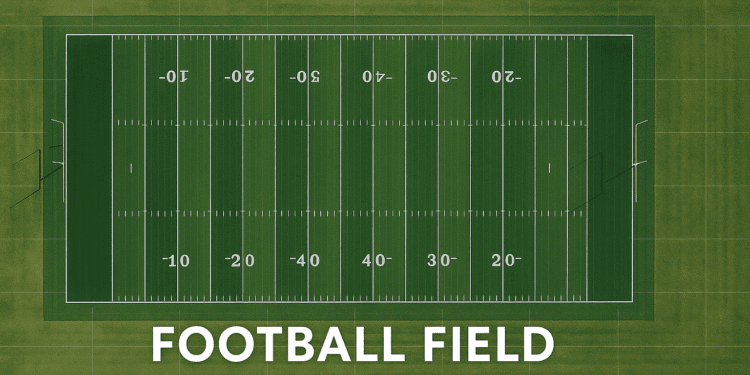How Many Acres is a Football Field: The Complete Guide to Football Field Dimensions
Have you ever wondered exactly how much land a football field covers? Whether you’re a sports enthusiast, property developer, or simply curious about measurements, understanding football field acreage is more useful than you might think. Let’s dive into this fascinating topic and break down everything you need to know about football field dimensions.
Understanding Football Field Basics
What Makes Up a Standard Football Field
A football field isn’t just a simple rectangle of grass. It’s a precisely measured playing surface that includes the main field of play, end zones, and surrounding areas. When we talk about football field acreage, we need to consider what exactly we’re measuring.
The standard American football field consists of the playing field itself, which measures 100 yards in length, plus two end zones of 10 yards each. This creates a total length of 120 yards from goal line to goal line. The width remains consistent at 53⅓ yards (160 feet) across the entire field.
The Importance of Knowing Field Dimensions
Why does this matter? Well, if you’re involved in construction, real estate, agriculture, or education, using a football field as a reference point can be incredibly helpful. It’s a measurement that most Americans can visualize, making it perfect for explaining large areas of land.
Official NFL Football Field Dimensions
Length and Width Specifications
Let’s get into the nitty-gritty details. An official NFL football field measures exactly:
- Length: 120 yards (360 feet) including end zones
- Width: 53⅓ yards (160 feet)
- Playing field only: 100 yards (300 feet) long
These measurements are standardized across all professional football leagues in the United States, ensuring consistency from stadium to stadium.
End Zones and Their Measurements
Each end zone adds 10 yards (30 feet) to the total field length. These areas are crucial for scoring touchdowns and are included in the total acreage calculation. Without the end zones, we’d only be measuring the playing field, which would give us a smaller total area.
Sideline and Boundary Requirements
Beyond the actual playing surface, NFL regulations require additional space around the field. Sidelines must extend at least 6 feet beyond the field boundaries, and there are specific requirements for team areas, bench zones, and safety margins.
Converting Football Field Dimensions to Acres
The Mathematical Calculation
Here’s where things get interesting. To convert a football field to acres, we need to:
- Calculate the total square footage
- Convert square feet to acres
Total area = Length × Width Total area = 360 feet × 160 feet = 57,600 square feet
Since one acre equals 43,560 square feet, we divide: 57,600 ÷ 43,560 = 1.32 acres
Step-by-Step Conversion Process
Let me walk you through this calculation step by step:
Step 1: Convert yards to feet
- Length: 120 yards × 3 feet/yard = 360 feet
- Width: 53⅓ yards × 3 feet/yard = 160 feet
Step 2: Calculate square footage
- 360 feet × 160 feet = 57,600 square feet
Step 3: Convert to acres
- 57,600 square feet ÷ 43,560 square feet per acre = 1.32 acres
Understanding Square Feet vs. Acres
This conversion helps put things in perspective. When someone says “about an acre and a third,” you can now visualize a football field. It’s a handy reference that makes large measurements more relatable.
Different Types of Football Fields and Their Acreage
Professional NFL Fields
As we’ve established, NFL fields measure 1.32 acres. This standard applies to all 32 NFL stadiums, whether they’re indoor or outdoor facilities.
College Football Field Dimensions
Interestingly, college football fields have identical dimensions to NFL fields. The NCAA requires the same 120-yard by 53⅓-yard measurements, so college fields also equal 1.32 acres.
High School Football Fields
High school fields can vary slightly, but most follow the same dimensional standards as professional and college fields. Some smaller schools might have slightly different dimensions due to space constraints, but the vast majority maintain the 1.32-acre standard.
Youth League Variations
Youth football often uses smaller fields. Pop Warner and other youth leagues might use fields that are:
- 80 yards long (including end zones)
- 40-45 yards wide
These smaller fields typically range from 0.7 to 0.9 acres, depending on the specific league requirements.
Comparing Football Fields to Other Common Areas
Football Field vs. Soccer Field
Soccer fields are actually larger than football fields. A regulation soccer field can range from 1.4 to 1.8 acres, depending on the specific dimensions chosen within FIFA’s allowable range.
Football Field vs. Baseball Diamond
A baseball field, including foul territory, typically covers about 2.5 acres. The irregular shape and extended foul territory make baseball fields significantly larger than football fields.
Real Estate Comparisons
When you’re looking at residential lots, a football field provides excellent perspective:
- A typical suburban lot might be 0.25 acres
- A football field equals about 5-6 average suburban lots
- An acre of farmland is slightly smaller than a football field
Why Football Field Acreage Matters
Property Development and Planning
Developers often use football fields as reference points when discussing large projects. It’s much easier to say “this development will cover 50 football fields” than to say “65.8 acres.”
Agricultural and Land Use Applications
Farmers and ranchers frequently think in terms of acres, but using football fields as a reference helps communicate with non-agricultural audiences. It’s particularly useful when discussing:
- Crop rotation areas
- Pasture sizes
- Conservation programs
Sports Facility Construction
When building new sports complexes, planners must consider not just the playing field but also parking, concessions, and spectator areas. A complete football facility might require 10-15 acres total.
Historical Evolution of Football Field Sizes
Early Football Field Dimensions
Football fields weren’t always standardized. In the sport’s early days, field sizes varied considerably between schools and regions. The push for standardization came as the game became more organized and competitive.
Standardization Process
The current dimensions were established through decades of refinement. The 120-yard length (including end zones) and 53⅓-yard width became official standards that have remained unchanged for generations.
Practical Applications of Football Field Measurements
Educational Uses
Teachers often use football fields to help students understand:
- Area and perimeter calculations
- Scale and proportion
- Metric conversions
- Real-world mathematics applications
Engineering and Construction Projects
Engineers and construction managers use football field references when:
- Explaining project scope to clients
- Calculating material needs
- Planning site logistics
- Communicating with stakeholders
The beauty of using a football field as a reference is its universal recognition. Almost everyone can visualize this space, making it an excellent tool for communication.
Conclusion
A football field covers exactly 1.32 acres, including both end zones. This measurement has remained constant across professional, college, and most high school levels, providing a reliable reference point for understanding large areas of land. Whether you’re involved in construction, real estate, agriculture, or education, knowing that a football field equals 1.32 acres gives you a valuable tool for visualizing and communicating about space.
The next time someone mentions acres of land, you can quickly convert that to football fields for better perspective. It’s a practical skill that bridges the gap between abstract measurements and tangible, visual understanding.
Frequently Asked Questions
Q1: How many football fields equal one square mile?
A1: One square mile contains 640 acres, so it would take approximately 485 football fields (640 ÷ 1.32 = 484.8) to equal one square mile.
Q2: Are Canadian football fields the same size as American football fields?
A2: No, Canadian football fields are larger. They measure 150 yards long (including end zones) by 65 yards wide, totaling approximately 1.9 acres.
Q3: How does a football field compare to a city block?
A3: City blocks vary significantly, but a typical city block ranges from 2-5 acres, making it roughly 1.5 to 4 times larger than a football field.
Q4: What’s the difference between the playing field and the total field area?
A4: The playing field (between goal lines) is 100 yards long and covers about 1.1 acres. The total field including end zones is 120 yards long and covers 1.32 acres.
Q5: How much area do you need for a complete football facility?
A5: A complete high school football facility typically requires 10-15 acres total, including the field, track, parking, concessions, and spectator seating areas.









